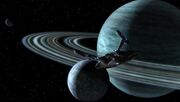(+stationary (fixed) orbit, w/ link to article at wikipedia) |
(+decaying orbit, from 'The Galileo Seven'; +extenral link to 'orbital decay' article at wikipedia) |
||
| Line 14: | Line 14: | ||
*'''Polar orbit''': A type of spacecraft orbit that passes within 22,300 miles of the geographic poles of a planet. An image of the ''[[Nimbus 1]]'' [[artificial satellite|satellite]] in polar orbit of [[Earth]] was seen in the [[USS Enterprise (NCC-1701) library computer|USS ''Enterprise'' library computer]]. ({{TOS|The Cage}}) A polar orbit may also be used as an [[Evasive maneuvers|evasive maneuver]], since [[Electromagnetism|electromagnetic]] interference from a planet's magnetic pole may disrupt starship [[sensor]]s. ({{TNG|Peak Performance|The Hunted}}) |
*'''Polar orbit''': A type of spacecraft orbit that passes within 22,300 miles of the geographic poles of a planet. An image of the ''[[Nimbus 1]]'' [[artificial satellite|satellite]] in polar orbit of [[Earth]] was seen in the [[USS Enterprise (NCC-1701) library computer|USS ''Enterprise'' library computer]]. ({{TOS|The Cage}}) A polar orbit may also be used as an [[Evasive maneuvers|evasive maneuver]], since [[Electromagnetism|electromagnetic]] interference from a planet's magnetic pole may disrupt starship [[sensor]]s. ({{TNG|Peak Performance|The Hunted}}) |
||
*'''Stationary orbit''' (aka '''Fixed orbit'''): In this type of orbit, the spacecraft orbits over the same spot on a planet. ({{TOS|Miri}}; {{TNG|Angel One|Interface}}; {{ENT|These Are the Voyages...}}) |
*'''Stationary orbit''' (aka '''Fixed orbit'''): In this type of orbit, the spacecraft orbits over the same spot on a planet. ({{TOS|Miri}}; {{TNG|Angel One|Interface}}; {{ENT|These Are the Voyages...}}) |
||
| + | *'''Decaying orbit''': In this type of orbit, the spacecraft will decrease its distance from the planet until it burns up in the planet's atmosphere. ({{TOS|The Galileo Seven}}) |
||
{{bginfo|It is safe to assume that standard and high orbit are simply orbits with a set of predefined speed and altitude parameters.}} |
{{bginfo|It is safe to assume that standard and high orbit are simply orbits with a set of predefined speed and altitude parameters.}} |
||
| Line 27: | Line 28: | ||
* {{wikipedia|Geostationary orbit}} |
* {{wikipedia|Geostationary orbit}} |
||
* {{wikipedia|Stationary orbit}} |
* {{wikipedia|Stationary orbit}} |
||
| + | * {{wikipedia|Orbital decay}} |
||
* {{mbeta}} |
* {{mbeta}} |
||
Revision as of 11:49, 23 September 2018


The USS Enterprise in orbit of an Earth-like planet

Nimbus 1 in polar orbit
Orbit, or orbital path, is a term used to describe the flight path of an object in space which has a repetitive motion and has a distinct center with respect to its flightpath.
A starship uses a form of orbit to maintain its relative position. The term orbit is also used to define the flight path of a planet within its own star system. (TNG: "Force of Nature")
In 2269, Spock detailed to Abraham Lincoln that the USS Enterprise was 643 miles, 2,021 feet, 2.04 inches above the surface of Excalbia. (TOS: "The Savage Curtain")
There are several forms of orbit; some of them are referred to by Starfleet personnel with names like "standard orbit" or "high orbit."
- Synchronous orbit: This form is used by a starship to maintain position towards a specific point on a planet's surface. The ship's velocity will be the same as the rotation speed of the planet. (TNG: "Relics")
- High orbit: A form of orbit in which the starship maintains a large distance from the planet's surface for safety reasons but is still close enough to use the transporter. (VOY: "Ex Post Facto", "The Omega Directive") The USS Voyager parked in high orbit over Earth, when it visited the planet in 1996, at an altitude of 20,000 kilometers. (VOY: "Future's End")
- Polar orbit: A type of spacecraft orbit that passes within 22,300 miles of the geographic poles of a planet. An image of the Nimbus 1 satellite in polar orbit of Earth was seen in the USS Enterprise library computer. (TOS: "The Cage") A polar orbit may also be used as an evasive maneuver, since electromagnetic interference from a planet's magnetic pole may disrupt starship sensors. (TNG: "Peak Performance", "The Hunted")
- Stationary orbit (aka Fixed orbit): In this type of orbit, the spacecraft orbits over the same spot on a planet. (TOS: "Miri"; TNG: "Angel One", "Interface"; ENT: "These Are the Voyages...")
- Decaying orbit: In this type of orbit, the spacecraft will decrease its distance from the planet until it burns up in the planet's atmosphere. (TOS: "The Galileo Seven")
Terok Nor (later Deep Space 9), was in synchronous orbit of Bajor during the Occupation. (DS9: "Emissary", "Necessary Evil", "Wrongs Darker Than Death or Night")
See also
External links
- Orbit at Wikipedia
- Synchronous orbit at Wikipedia
- Geostationary orbit at Wikipedia
- Stationary orbit at Wikipedia
- Orbital decay at Wikipedia
- Orbit at Memory Beta, the wiki for licensed Star Trek works
